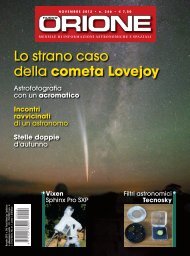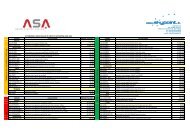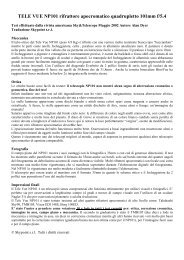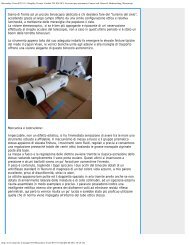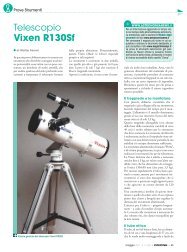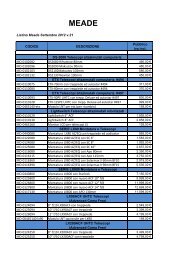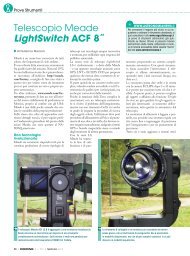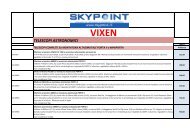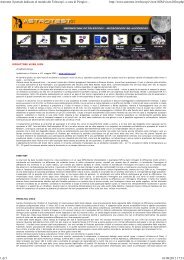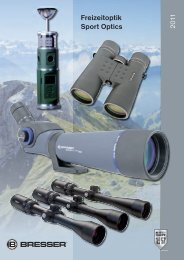CONFRONTO CON IL FILTRO H-ALFA BAADER - Skypoint Srl
CONFRONTO CON IL FILTRO H-ALFA BAADER - Skypoint Srl
CONFRONTO CON IL FILTRO H-ALFA BAADER - Skypoint Srl
Create successful ePaper yourself
Turn your PDF publications into a flip-book with our unique Google optimized e-Paper software.
SKYPOINT s.r.l.<br />
VIA ZORUTTI (S.S.13) 145/11 CAMPOFORMIDO – UDINE –<br />
TEL 0432 652609 FAX 0432 663473 www.skypoint.it e-mail: info@skypoint.it<br />
<strong><strong>CON</strong>FRONTO</strong> <strong>CON</strong> <strong>IL</strong> F<strong>IL</strong>TRO H-<strong>ALFA</strong> <strong>BAADER</strong><br />
Recently, Baader Planetarium, a manufacturer and distributor of astronomical equipment in Mammendorf,<br />
Germany, introduced a Hydrogen-alpha, or H-a, 656 nm filter specifically designed for astrophotography<br />
using CCD cameras. The filter is stated to have a FWHM (full-width at half-maximum intensity) of 7 nm and<br />
a transmission of 90% and is made with scratch-resistant coating technology. The interesting aspect of this<br />
introduction is the list price of $335 for a 50.8 mm diameter filter. This price includes several markups for the<br />
primary and secondary U.S. distributors. This is considerably less than list price of the 4.5 nm Custom<br />
Scientific H-a filter at $595 or 6 nm Astrodon at $695. The purpose of this study is to compare the Baader<br />
filter with the Astrodon 6 nm H-a filter.<br />
Spectral curves were obtained using Varian Cary 500 high resolution spectrophotometer.<br />
The Astrodon 6 nm filter reaches its maximum throughput of 92.3 %T at the H-a emission wavelength of<br />
656.3 nm. The Baader 7 nm filter reaches its maximum throughput of 89.1%T at 657.5 nm. However, it only<br />
reaches 85.8 %T at the H-a emission wavelength.<br />
Some manufacturers design their peak transmissions on the high side of the emission wavelength, since the<br />
passband shifts toward shorter wavelengths with faster optics. Studies underway show that the Astrodon<br />
filter will maintain its >88%T specification with systems slower than about f/4.5. An angular study has not<br />
been performed on the Baader filter. However, if this spectrum is representative, its use with f/7-10 systems<br />
will be degraded due to its 85%T relative to 92%T of the Astrodon. This goes to the Signal (S) part of the<br />
equation to determine the signal-to-noise, S/N, of the filter.<br />
Narrower filters are nearly always preferred. The problem with narrower filters is manufacturing<br />
reproducibility. For example, Custom Scientific 4.5 nm FWHM filter are specified to have maximum %T<br />
(throughput) >70%. Some filters have 90% and others near 70%. This does not reflect negatively on the<br />
quality of these filters. It is just a recognition of the fact that narrow filter are more difficult to make<br />
<strong>CON</strong>SISTENTLY. We do not have access to different lots of Baader H-a filters, but we can present such<br />
lot-to-lot data for recent Astrodon 6 nm H-a filters, as shown below:
SKYPOINT s.r.l.<br />
VIA ZORUTTI (S.S.13) 145/11 CAMPOFORMIDO – UDINE –<br />
TEL 0432 652609 FAX 0432 663473 www.skypoint.it e-mail: info@skypoint.it<br />
Three of the most important parameters in narrowband filters are the FWHM, the maximum %T and the out-of-band<br />
blocking. We have discussed the first two, and most people are somewhat familiar with what they mean. The out-ofband<br />
blocking is very important. It refers to the degree to which light is rejected OUTSIDE of the passband. Poorer outof-band<br />
blocking will let more light come through your filter, degrading its contrast.<br />
Realize that these H-a filtes let light pass in about a 10-12 nm region, whereas the silicon-based CCD detectors used in<br />
amatuer cameras are sensitive to light from the ultra-violet (UV) to the near-infrared (NIR) up to about 1100 nm. Thus,<br />
more and more coating layers are needed to eliminate the potential light leakage of the filter outside its passband. If you<br />
integrate the area under the curve from 300 to 1100 nm compared to just the area under the curve of the narrow<br />
passband, a small amount of out-of-band leakage adds up quickly. This, in fact, is how you characterize the <strong>CON</strong>TRAST<br />
of a filter relative to a chosen detector and light source.<br />
You cannot see how much light is leaking through the filter outside the passband in %T plots, as shown above. The<br />
signal would be
SKYPOINT s.r.l.<br />
VIA ZORUTTI (S.S.13) 145/11 CAMPOFORMIDO – UDINE –<br />
TEL 0432 652609 FAX 0432 663473 www.skypoint.it e-mail: info@skypoint.it<br />
The comparion of out-of-band blocking between the Astrodon 6 nm and Baader 7 nm H-a filters is show<br />
below:<br />
The NIR (>700 nm) difference is large. Both filters have excellent out-of-band blocking at shorter<br />
wavelengths of OD 6. However, the Baader filter has significantly poorer out-of-band blocking at NIR<br />
wavelengths where many CCD detectors still have considerable sensitivity, such as the KAF3200ME,<br />
KAF6303, back-thinned detectors and the new large KAF16803 andKAF09000. This difference is nearly 3<br />
orders of magnitude and certainly explains part of the cost difference.<br />
This would not be acceptable for professional filters, and Astrodon (and Custom Scientific) filters are made to<br />
professional standards. How does this affect the type of astrophotography mostly done by amatuer<br />
imagers? It will likely not make much of a difference for bright objects, such as M16, M20, the Veil<br />
Supernova remnant, etc. As with narrower filters, it will manifest itself in the fainter areas and fine detail, e.g.<br />
contrast.<br />
To test NIR leakage, I used an Apogee Alta U16M CCD with a Kodak KAF16803 large format CCD<br />
operated at -20C in my dimly lit office with a standard flashlight directed at the ceiling. A flashlight was used<br />
over just a few minutes of time, so changes in lamp intensity should not be a factor. Further, the overhead<br />
room lights are the coiled fluorescent bulbs, and a continuum from an incandescent bulb with NIR intensity<br />
was most appropriate. A calibrated light source is unnecessary to demonstrate the difference in S/N and light<br />
leakage in these tests. The camera was pointed up. A 2" nose piece was secured into the camera holding<br />
a standard 48 mm Astrodon Schuler photometric (Bessell, Johnson-Cousins) IR filter made with 3 mm thick<br />
piece of Schott RG9 glass and 1 mm of KG4 glass. This filter is used to compare the IR leakage of the two<br />
H-a filters, because it blocks the filter's bandpass and all shorter wavelengths. It's scan (Is) is shown below:
SKYPOINT s.r.l.<br />
VIA ZORUTTI (S.S.13) 145/11 CAMPOFORMIDO – UDINE –<br />
TEL 0432 652609 FAX 0432 663473 www.skypoint.it e-mail: info@skypoint.it<br />
MaxImDL was used to collect the 4s scans and CCDStack was used to define identical regions on all scans<br />
and compute the image statistics.<br />
LEFT: Apogee U16M with Bessell IR filter in 2" nose piece<br />
CENTER: H-a filter placed over opening above IR filter<br />
RIGHT: Stack of AP tubes pointed at dimly lit ceiling
SKYPOINT s.r.l.<br />
VIA ZORUTTI (S.S.13) 145/11 CAMPOFORMIDO – UDINE –<br />
TEL 0432 652609 FAX 0432 663473 www.skypoint.it e-mail: info@skypoint.it<br />
LEFT: Photometric IR filter only MEAN ADU 64,074 (saturated) RIGHT: Astrodon 6 nm H-a with ~6 OD Blocking MEAN ADU 332
SKYPOINT s.r.l.<br />
VIA ZORUTTI (S.S.13) 145/11 CAMPOFORMIDO – UDINE –<br />
TEL 0432 652609 FAX 0432 663473 www.skypoint.it e-mail: info@skypoint.it<br />
Baader 7 nm H-a with ~ 2.5 OD Blocking Mean ADU 10,022<br />
Thus, even blocking nearly all UV and VISIBLE light with the IR filter, the KAF16803 detector in the CCD<br />
was saturated with only a flashlight pointed to the ceiling in these tests. The Astrodon 6 nm FWHM H-a filter<br />
rejected all but 332 ADU, whereas the Baader 7 nm filter allowed 10,022 ADU. Thus, the Baader allows a<br />
factor of 10022/332 = 30.2 times the amout of NIR light through that the Astrodon filter rejects with this<br />
camera and broadband incandescent light source. This, of course, is expected from the spectral scans that<br />
show considerably more NIR light leakage from the Baader filter. [Note - there was a dark horizontal band in<br />
the Astrodon image above in the original posting. One of the three frams showed this for unknown reasons.<br />
The above represents a second FITs file take at the same time. The earlier results showed 365 mean ADU<br />
and this showed 332 mean ADU. Thus, this small change is likely within experimental error and does not<br />
change any conclusion].<br />
So, what does all this mean for imaging? As most of you know or suspect, attractive H-a images can be<br />
taken with a variety filtes from the wide 13 nm Astronomik, the 9 nm Astrodon-Schuler, the 7 nm Baader, the<br />
6 nm Astrodon, the 4.5 nm SBIG/Custom Scientific and the special order Custom Scientific 3 nm. There is<br />
no right answer because it depends upon your budget and your objectives for H-a imaging. Greater<br />
transmission with the same FWHM increases S/N. Narrower filters with the same transmission increase<br />
S/N. Thus, with the above optical performance, you will more likely be looking at subtle differences in<br />
contrast with lower level, or background features. With this in mind, we will determine the S/N of several<br />
areas of the Eagle Nebula, M16 taken on the same night under idential condtions with the U16M on an<br />
RCOS 12.5" RC reflector with the Baader 7 nm and Astrodon 6 nm H-a filters. The S/N was determined in<br />
MaxIm, using the following formula (ADU was multipled by the camera gain of 1.2 to convert to e-):<br />
S/N = [(signal - background) ] / sqrt [ Signal + background standard deviation^2 ]
SKYPOINT s.r.l.<br />
VIA ZORUTTI (S.S.13) 145/11 CAMPOFORMIDO – UDINE –<br />
TEL 0432 652609 FAX 0432 663473 www.skypoint.it e-mail: info@skypoint.it<br />
The regions shown were taken in areas without stars. The same dark background region was used (not<br />
shown). The Baader 7nm H-a filter is on the left and the 6 nm Astrodon H-a filter is on the right. A brighter<br />
region next to the Eagle Nebula is analyzed first.<br />
Baader S/N = 3.69; Astrodon S/N = 4.10 11% improvement with Astrodon<br />
A darker region further away is analyzed next:<br />
Baader S/N = 0.92; Astrodon S/N = 1.11 21% improvement with Astrodon.<br />
A brighter region with ridge structure inside the nebula resulted in an improvement in S/N with the Astrodon filter of only<br />
4%. This is consistent with the expectations described above. Both filters produce a pleasing image of the Eagle<br />
Nebula. The advantages of the narrower filter with slightly higher transmission and much better out-of-band blocking<br />
show up in fainter areas and are thus more subtle. Again it really depends upon your goals in astrophotography.<br />
Astrodon will continue to make the best off-the-shelf narrowband filters possible for astrophotography, even if they are<br />
more expensive. We will not sacrifice blocking, transmission, prevention of halos, or manufacturing consistency for a<br />
lower narowband price. For some of you, this is overkill. For others who have spent thousands or even tens of thousands<br />
of dollars or Euros on scopes, mounts and cameras, we offer you filters wihtout compromise.<br />
In short, as in any other aspect of life, there is "no free lunch".






